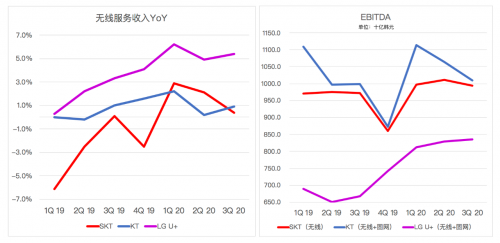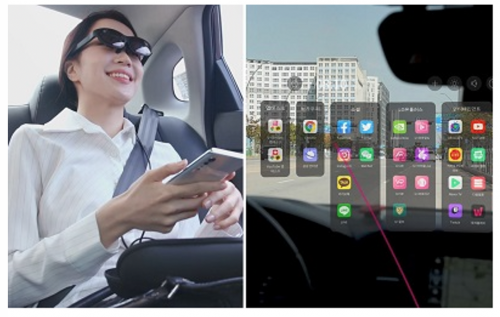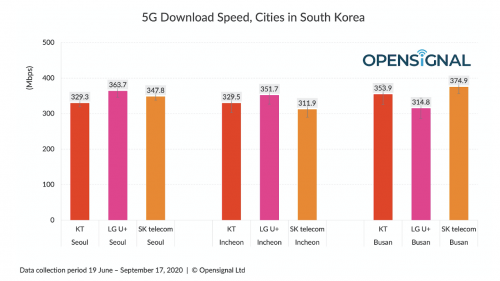SKT and LG U+ continued to exceed expectations in the third quarter!
SKT and LG U+ double-digit growth in operating profit in the third quarter!
On November 6, 2020, the three major operators in South Korea released their 2020 Q3 financial reports. Both SKT and LG U+ exceeded market expectations, and major Korean media rushed to report.
The financial report shows:
SKT’s third-quarter sales increased by 3.7% year-on-year, and operating profit increased by 19.7% year-on-year; LG U+’s third-quarter sales increased by 5.9% year-on-year, and operating profit increased by 60.6% year-on-year.
The operating profits of these two operators have achieved double-digit growth for two consecutive quarters. In the second quarter of 2020, SKT sales increased by 3.7% year-on-year, operating profit increased by 11.4% year-on-year; LG U+ sales increased by 5.1% year-on-year, and operating profit increased by 59.2% year-on-year.
Despite the severe impact of the epidemic, the revenue and profits of these two major operators have increased significantly. LG U+’s operating profit has increased by more than 50% for two consecutive quarters. It is no wonder that the always demanding Korean media also praised them.


Speaking of the impact of the epidemic, another South Korean operator, KT, said that the travel and hotel businesses of its subsidiaries such as BC Card and KT Estate were directly affected by the epidemic, and labor costs increased, which led to a reduction in the group’s total sales. And operating profit. KT explained that if you only look at the main communications business, KT, like the other two operators, achieved growth in both sales and operating profit in the first three quarters of this year, with business revenue increasing by 0.4% and operating profit by 1.4%.
In other words, under the influence of the epidemic, South Korea’s economy has fallen into a downturn. Among them, exports fell by 10% and GDP fell by 2.7%. However, the performance of the three major operators in South Korea has bucked the trend and has strongly supported the recovery of the economy. Beautiful economic landscape.
What is the reason behind it?
“5G effect” continues to appear
South Korean operators said that thanks to the growth of 5G users, sales of wireless services have achieved growth compared to the same period last year.
Since the commercialization of 5G in South Korea in April 2019, the number of 5G users of the three major operators in South Korea has continued to increase. As of the third quarter of 2020, the total number of 5G users in South Korea has reached 9.25 million.
As the number of 5G users continues to increase, the statistical financial report data found that since the commercialization of 5G in South Korea in April 2019, the sales and profits of the three major operators in South Korea have shown steady growth in wireless business sales. It can be said that 5G is the business of the three major operators. the key to success.
As shown in the figure above, especially LG U+, its wireless business revenue and profits are rising as if they were hanging up.

At the end of September, the Korean media summarized the three highlights of the 18 months of commercial use of 5G in South Korea:
1) The rapid development of 5G users: The number of 5G users is 9.25 million, and the penetration rate of 5G users is 16%. It is expected that the number of users will reach more than 11 million by the end of the year, and the user penetration rate will reach 20%, which will exceed the 20% penetration rate.
2) Good 5G user experience: The average download rate of 5G is 656.56Mbps;
3) 5G users love to use it, and the traffic surges:
• The average monthly data consumption of 5G users is 27GB;
• The monthly consumption data of 5G users is 2.7 times that of 4G;
• 5G accounts for one-third of total mobile traffic.
Only 16% of 5G users contribute one third of the total mobile traffic! It is not difficult to see that the commercial success of 5G in South Korea is an important driving force for operators to achieve both revenue and profit growth.
What are the key driving factors behind the successful commercialization of 5G in South Korea? What experience is there to learn from?
Rich 5G services continue to attract users
5G users continue to grow and consume one-third of the mobile data traffic. Behind these data shows that 5G innovative services in South Korea continue to attract users.
South Korea’s early 5G services mainly focused on eMBB scenarios, and continuously introduced a variety of services such as ultra-high-definition video, VR/AR to consumers, involving multiple industries such as sports, games, entertainment, and education.
Take LG U+ as an example. Since the commercialization of 5G, this operator has continuously increased investment in AR/VR services and expanded content services through the three stages of U+ 5G 1.0, U+ 5G 2.0, and U+ 5G 3.0, which has continued to promote users online Consumption upgrades in video/games and other services have doubled the utilization rate of 5G users relative to 4G users. Among them, the utilization rate of online video increased by 3.6 times, and the utilization rate of online games increased by 2.7 times, which led to a rapid increase in the proportion of 5G traffic.
The 1.0 stage 5G content service is mainly for sports and entertainment, such as 360-degree VR viewing, VR yoga teaching, etc.; the 2.0 stage extends to games and daily life, such as cloud/VR games, AR shopping, etc.; the 3.0 stage further extends to the education industry , Such as 3D AR children’s library, VR English dialogue, etc.
In July of this year, LG U+ also launched a VR service in conjunction with the hotel, where you can enjoy 15 types of VR games and more than 1,300 VR videos; in August, LG U+ realized the commercialization of the world’s B2C AR glasses for the first time, and the display size can be expanded to the maximum Above 100 inches, you can adjust the degree of the lens according to your eyesight, watch YouTube, Netflix and other content, and experience an overwhelming sense of substitution.
The world’s first B2C AR commercial glasses
Attracted by abundant 5G services and content, and the epidemic has fostered new user online behaviors, 5G services in South Korea have continued to spread. For example, during the epidemic, a large number of South Korean users watched Korean professional baseball games immersively through 5G VR. 44% of visits; users who also subscribe to 5G VR yoga, VR games, VR education and other content are growing rapidly. It is believed that as 5G users surpass the 20% penetration rate, the high-quality content of VR/AR continues to be enriched, and VR/AR terminals continue to innovate and make breakthroughs. VR and AR are expected to become the real killer services of 5G.
A good 5G network experience is the cornerstone of business success
South Korea has built a 5G network covering almost the whole country, covering 85% of the cities and 95% of the population. In June, the Korean Ministry of Science and Information and Communication Technology organized the first 5G quality assessment. The evaluation result shows that the average download rate of 5G in South Korea is 656.56Mbps, which is 4.1 times higher than that of LTE; the average upload rate is 64.16Mbps, which is 1.5 times higher than that of LTE. In terms of 5G coverage, the 5G availability rate is 67.93% in shopping malls and large hospitals, 76.33% in the subway scene, 78.21% in the main traffic road scene, and 76.22% in the high-speed rail scene.
Coincidentally, in August, ZDNet Korea, a well-known professional IT network media in South Korea, conducted random tests in Seoul, South Korea, based on consumer habits, including Gwanghwamun Intersection, Seoul City Hall Plaza, Hongdae Oulmadang Road, Subway Gangnam Station Intersection and In places where users are densely populated such as the Jamsil Station intersection, the average download speed of users reached 716Mbps and the upload speed was 95Mbps. LG U+ was the fastest, with an average download speed of 771Mbps and an upload speed of 102.1Mbps.
On October 29th, Opensignal, an international network speed testing agency, released the report “5G Experience in Korean Cities” for the first time, pointing out the average 5G downloads of the three major mobile operators KT, LG U+, and SKT in South Korea’s top 3 cities, namely Seoul, Incheon and Busan. The speed exceeds 300Mbps. The speed test is the business experience rate of many users when experiencing various business applications such as brushing Douyin/watching videos/webpages, etc. The rate is limited by various application servers and is low, such as insufficient access bandwidth of application servers, Insufficient server processing power, etc.
Among them, in Seoul, the South Korean capital, LG U+ users have the highest average 5G download speed at 363.7Mbps; in Incheon, LG U+ users still have the highest average 5G download speed at 351.7Mbps; in Busan, SKT users’ average 5G download speed The highest is 374.9Mbps.
Without wide roads, there will be no endless streams of vehicles. A good 5G network experience has built a solid foundation for the development of South Korea’s 5G business. So, since its commercialization for more than a year, how has South Korea’s 5G continued to consolidate the foundation of the 5G network? Let’s take LG U+ with leading 5G network performance as an example to see how South Korea’s 5G has achieved continuous improvement in network performance.
First of all, business drives network construction standards and network construction ideas.
As mentioned above, new video services such as VR/AR are the main driving force for the doubling of network traffic. In order to meet the large traffic demand of these services and allow users to enjoy a smooth experience anytime and anywhere, LG U+ first developed around VR/AR and other services The 5G network construction standards: 400Mbps outdoors, 100Mbps indoors anytime, anywhere.
At the same time, considering the trend of continuous business development, LG U+ also formulated a network construction idea of ”gradual investment focus shifting from urban to rural areas and from outdoor to indoor”:
• In 2020, the focus will be on the full coverage of Seoul and 6 major cities, including indoor coverage, while the other 85 small and medium-sized cities will focus on outdoor coverage
• Full coverage in 85 small and medium-sized cities nationwide in 2021
• Achieve full national coverage by 2022
Secondly, continuous technological innovation promotes continuous improvement of network performance, including key technologies such as Massive MIMO and SRS Tianxuan.
As we all know, Massive MIMO is the core technology of 5G NR, and its product forms include 64T64R and 32T32R. Among them, the 64T64R has more antennas, more channels, stronger coverage, larger capacity, and better experience for users, but the disadvantage is that it will be larger and heavier.

In the early stage of 5G construction in South Korea in 2019, due to engineering issues that require lighter 5G AAUs, most sites can only deploy 32T32R equipment. This has led to insufficient 5G indoor coverage in South Korea, and indoor 30Mbps rate satisfaction is about 70%.
In order to improve the user experience, LG U+ uses Huawei’s third-generation Massive-MIMO equipment, which has been significantly reduced in weight, to achieve simple deployment of 64T64R equipment and greatly improve network performance. LG U+’s actual measurement in Seoul showed that compared with 32T32R, under 64T64R equipment, indoor user rate near windows increased by more than 20%, indoor middle area increased by more than 30%, signal coverage (RSRP) increased by 5dB, and 5G increased significantly Indoor coverage capacity.

In summary, since the three major operators in South Korea commercialized 5G on April 3, 2019, their 5G networks have continued to expand, the number of 5G users has continued to grow, 5G services and content have continued to be enriched, 5G experience has also continued to improve, and operators’ wireless revenues And profits have also continued to grow, and the success of 5G in South Korea has become increasingly apparent. Persistent business and network investment, as well as continuous technological innovation and network performance optimization, are the key driving forces behind South Korea’s 5G success.
The article comes from the Internet, reminder: news and comments do not represent the position of this website






